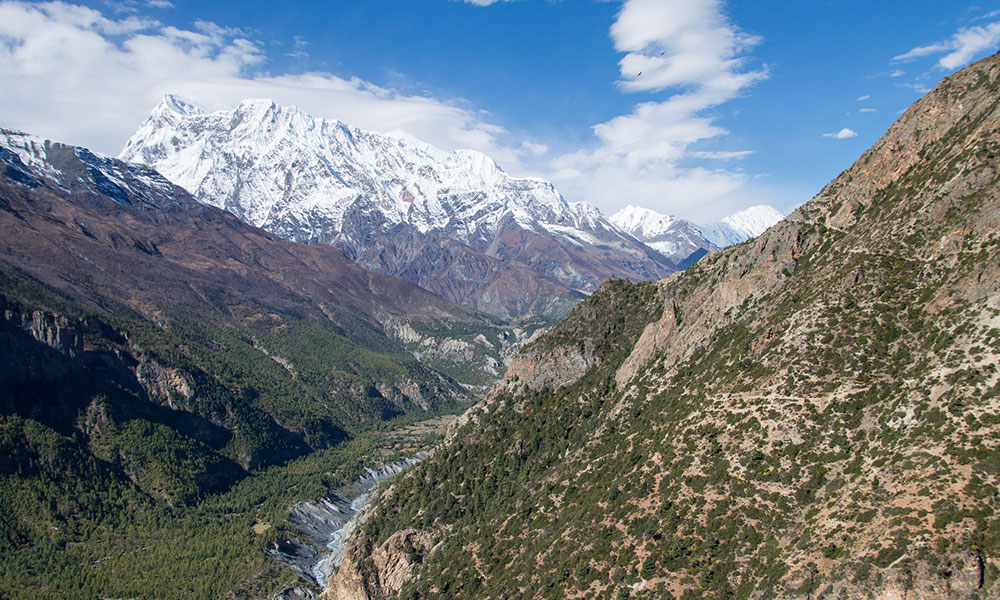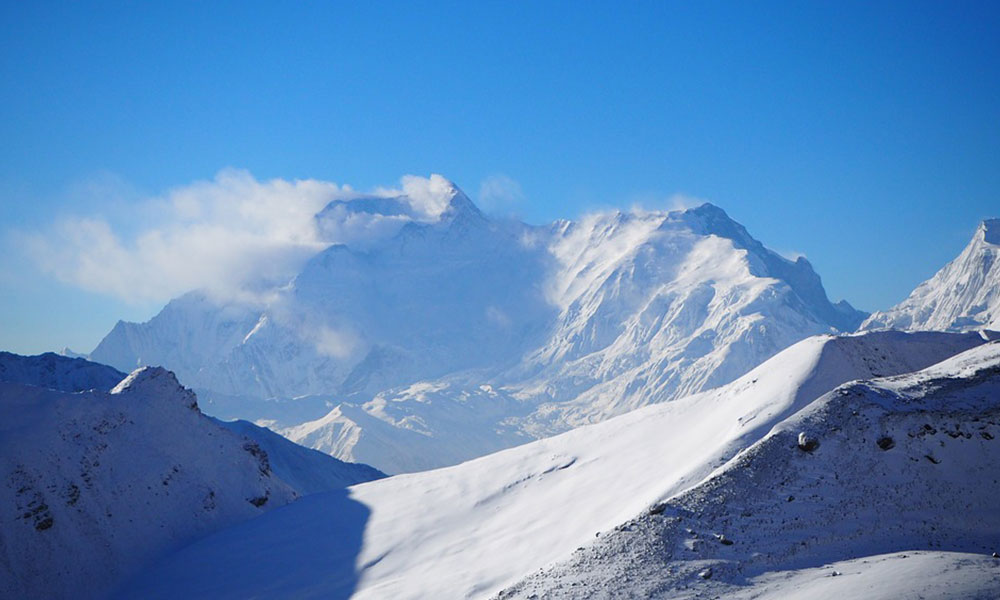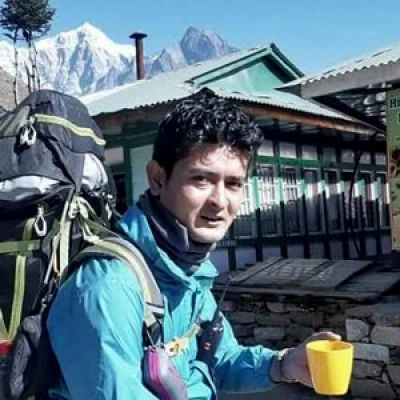The Annapurna Region is familiar with four seasons: Summer, Autumn, Winter, and Spring. Most of the trek to the mountainous region in Nepal is not possible all around the year. However, being a rain-shadowed region makes Annapurna Circuit Trek an exception. It is possible to experience the charm of trekking to the Annapurnas in all seasons.
Moreover, Annapurna Circuit Trek can be fairly difficult on two seasons: Winter and Monsoon Season in comparison to Summer and Autumn seasons.
Annapurna Circuit Trek Weather and Temperature get much colder in the Winter season. The temperature drops below the freezing point in most of the trail. The highest part of the trails is covered with thick snow which can block the trail sometimes. The beginning of December is safe to avoid snow blockades if you chose the winter season for trekking here. You might also need extra gear and backpacking during this season.
Annapurna Circuit Trekking can be done in Monsoon season as most(northern) parts of the trail are rain-shadowed. There are chances of mudslides and landslides on the lower regions of the route during Monsoon Season. Leeches will possibly trouble you on the trails on lower regions. Monsoon season attracts relatively less number of travelers in this reason. Most of the scenic views of the mountains can get obscured. Still, trekking during monsoon season is much adventurous in the Annapurna region.
Annapurna Circuit Weather and Temperature – October and November
October and November are the popular trekking months in Nepal. Like all the other trekking destinations, Annapurna Circuit is also filled with a bunch of trekkers and visitors from all across the world during this season. These two months are regarded as autumn in Nepal.
The sky is clear blue with no obstruction from clouds. The scenic and mesmerizing view of Annapurna Massif(Annapurna I-IV), Machhapuchhre, Manaslu, Dhaulagiri, and other peaks standing 6000m-8000m tall from the sea level can be seen during the trek. Monsoon has already ended so chances of rain-shower and snowfall are less to none.
Annapurna Circuit Trek Weather and Temperature are perfect in October and November because you don’t have to experience extreme heat or cold. Days are quite warm in the lower regions and nights are cooler. The average day temperature during these months is 15°C. During the night time, the temperature won’t get below 7-8°C.
You can expect the temperature below freezing on the higher elevations like Thorung La Pass. Weather is unpredictable and can change anytime all around the year in this region. Warm and protective clothing is recommended while trekking on Annapurna Circuit in this season. You will be astonished by the clear view of the star-filled sky at night. To get enough of this Annapurna Circuit Trek, the autumn season is the best in every possible way.
Annapurna Circuit Weather and Temperature – March to May
Annapurna Circuit Trek Weather and Temperature is moderate to hot in the months of March, April and May. These months are regarded as Spring season in Nepal, the second best time to do the Annapurna Circuit Trek. Spring season is known as the season of colors. Flowers of several kinds including rhododendron will be blooming all over the forest in the lower regions.
The humidity in the air is less and the weather remains quite stable after the harsh winter is gone. You will be immensely pleased to gaze at serene high-mountains and walk through the beautiful villages of Manang. Tourist hubs like Pokhara are bustled with the crowd as Nepali New Year falls in the Spring season.
The average temperature of the Annapurna Region can get up to 20°C during the spring season. The nights are cooler in the lower region and temperature decreases proportionately as the altitude increases. Muktinath region is drier as it receives very little to no rainfall. Higher altitude regions(4000m and above) have chilling mornings and evenings with a temperature close to the freezing point. Clothing fabrics made of cotton, linen, eyelet are most comfortable to wear in layers in hot and dry regions. Thick and protective clothing in layers is recommended in the cold higher regions of the Annapurna Circuit Trek.

Annapurna Circuit Weather and Temperature – June to August
Monsoon season starts from mid-June and lasts till early September in Nepal. The monsoon season is often regarded as off-season for trekking other routes in Nepal. As most part of the Annapurna Circuit Trail lies in the rain-shadowed area, trekking is doable in monsoon season also. The southern-lower portion of the trail might get muddy and quite slippery due to heavy rainfalls. Good trekking equipment, gear and essentials like trek boot with solid grip are important. Mosquitoes and leeches are also expected in the lower regions during this season.
Special gears and equipment are vital for trekking Annapurna Circuit during the monsoon season. Rain protective clothing might come handy while trekking on the lower regions.
During the month of July, the monsoon winds arriving from the Bay of Bengal reach its peak. It causes heavy rainfall with lightning and thunderstorms on hills and thick snowfall in the higher altitudes. Weather is generally cloudy and sudden climatic changes are very common. The air becomes more humid because of the rainfall in the evening and bright sunshine during the days. During summer/monsoon, the temperature of the region remains similar to the spring season. Cleared sky after heavy rainfalls may come up with hot sunny days whereas weather may get chilly in the mornings and evenings in case of rainfall. The average temperature stays between 15 - 25°C on the lower region and it gets colder as the altitude increases.
During this season almost 70 percent of the annual rainshower falls to the ground. Chances of landslides and mudslides are high in the lower regions. Often roads, highways like Prithvi Highway(Kathmandu-Pokhara) gets blocked by landslides during the monsoon season. You must research about the local weather and prepare accordingly if you are willing to trek on monsoon season.
Annapurna Circuit Weather and Temperature – December to January
Winter peaks in the months of December, starting from mid-November in Nepal. High mountains are covered with snow and the sky is clear and blue. You will able to get unobstructed views of the snow-crowned mountains and snow-filled trails make trekking really exciting. Lodges and trails are least crowded in comparison to the peak-seasons. Mountainous trails are covered with thick snow making it a bit harsh to trek. Heavy Snowfall can last up to 36 hours in favored condition. You should be aware of the local weather patterns and stay alert in the higher altitudes.
The temperature nearly reaches the freezing point on the lower regions. On the higher altitudes, the temperature is negative below the freezing point. December is most likely to have to lowest precipitation and higher passes have good chances remaining open. You should be careful while crossing Thorung La pass. It is great if you got to pass Thorung La as early as you can because stormy cold wind starts to blow after 9 am. You should be prepared to face the challenging weather if necessary.
The temperature of the Annapurna Circuit trek remains 5-10°C on average. The temperature on the higher altitudes might get as low as minus 20 degrees Celcius. If you are likely to do Annapurna Circuit Trek during the winter season, warm clothing and sleeping bags that can bear up to minus 20-40 degrees are recommended. You can also hire these sleeping bags in Kathmandu.
Annapurna Circuit Weather and Temperature- September and February
It would not be unfair to say that September is the best trekking month for all trekking in Nepal. September month is regarded as Autumn season and trails are filled with trains of trekkers. Fellow trekkers from across the world add joy in the Annapurna Circuit Trek during this month.
Summer monsoon will be already gone by this time and the sky is clear with no clouds. Annapurna Circuit Trek offers an excellent view of Annapurnas, Dhaulagiri, Manaslu and other peaks in the Annapurna ranges. Weather is much favorable for trekking to the mountainous trails as there are very fewer chances of rain and snowfall. Light rainfall is not uncommon during early-September on the Annapurna Region.
The Annapurna Circuit Trek Temperature is quite warm during day time. The temperature of the lower region(below 2500m) varies from 15-23°C and less than 10 °C in the higher altitude(4000m and above) on average. The highest point of the trek, Thorung La and Thorung Phedi area may have a temperature below freezing point.
The month of February is the transition period leaving behind harsh winter and approaching the warm summer on Annapurna Circuit Trek. The trails that continue after Manang have cold weather. It may get quite cold and there are chances of Thorang La pass getting closed due to the winter snowfall sometimes. The trails can be covered with ices and one should be careful while walking. Days are shorter in February and it will be dark by 5 pm decreasing the temperature. You can hope for clear weather if you are willing to do Annapurna Circuit in February.

Related Trips:
You can also book the complete package for the trek. The itinerary can be customized according to your choices and the appropriate timings. For further details, you can email us at info@indexadventure.com
Final Say
The Annapurna Region is one of the most beautiful places that you can travel in Nepal. It is accessible throughout the year and the feel of trekking in every season is very distinct. Well planned trek with enough preparation and precautions will definitely help you to make unforgettable memories in this trek.
Depending upon the season you are willing to trek, special gear and equipment should be chosen. This makes it a lot easier for you to enjoy every moment of your trek and make it hassle-free. Whichever season you chose to trek to the Annapurnas, it will provide you with fulfilling experience, and it really is an escape to the wilderness and serene mountains of the Annapurna Region.







